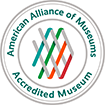Long Beach Museum of Art’s New Exhibit Questions What’s Real, What’s Not in History
As large wooden crates arrived at the Long Beach Museum of Art on a recent morning, Echo Park artist F. Scott Hess reached inside one of the boxes to carefully pull out a historic family heirloom. It was a gray Confederate cavalry jacket that once belonged to his ancestor, Brig. Gen. Alfred Iverson, who fought in the Civil War.
According to Hess, the wool coat was hand-tailored in Rome, Ga., in 1894, and it showed its age. It is faded and splattered with red spots that may have been blood, Hess pointed out as he put it on.
“He (Iverson) had a father of the same name who was a senator and helped start the Civil War, and his son helped to lose it,” Hess said.
The coat is one of more than 100 artifacts, paintings, prints and other objects that make up “The Paternal Suit: Heirlooms from the F. Scott Hess Family Foundation,” which is the largest exhibition of the year for the museum. It opens Thursday and will encompass all of the gallery spaces through Oct. 5.
It’s also an elaborate performance piece and a bit of a prank since most of it, if not all of it, may or may not have really happened as Hess tells it.
The exhibition follows Hess’ family history from 17th century England through early American settlements to the present. He uses his family’s story — visually enhanced with artifacts like decorative fireplace tiles from an old Southern plantation, early 19th century dueling pistols, and artwork like an oil painting depicting a Revolutionary War battle — to trace U.S. history.
But the priceless antique family relics in the exhibition, like the blood-stained coat Hess carefully removed from the wooden crate, were really created by the artist. Nevertheless, they are being presented as legitimate historical artifacts along with supporting documents, photographs, newspaper clippings and other historical items also meticulously created by Hess.
His family ancestry is interwoven with historic events and detailed stories behind each object on display.
Hess also created fictional artists to take credit for the majority of the works on display while referring to himself as the director of the F. Scott Hess Family Foundation who “collected” the works for the exhibition.
Although he stayed in character as the director of the foundation throughout an interview, Hess hasn’t gone mad; it’s all an examination of history, authority, deception and perceived truths. It’s also an impressive display of the artist’s eclectic talents.
“If you don’t know anything about it, as you approach it, it’s really sort of a history of a family and genealogy, and discoveries the artist was making along the way,” said Ron Nelson, executive director of the museum. “But he chose to fabricate part of it — a lot of it — and along with that, worked in multimedia and did pieces of ceramics, oil paintings, created family heirlooms that are so convincing you would think that indeed the storyline and everything about them would be absolutely true.”
Nelson, however, pointed out that there are a few actual relics in the exhibition, although neither he nor Hess is saying which ones are real and which aren’t.
Known primarily as a figurative painter, Hess’ work is in collections at places like the Los Angeles County Museum of Art, the Orange County Museum of Art, the Smithsonian Institution and the Oakland Museum of California. He has also exhibited his work in Europe, Asia and the Middle East.
The Long Beach museum is the last stop for “The Paternal Suit,” which has traveled nationally since August 2012.
Hess has been working on the exhibit since 2004, a few years after he made contact with his father, whom he hadn’t seen since he was a boy. That reunion sparked an interest in his family history and years later he began to look into his paternal family lineage and uncovered a prominent ancestry that went back centuries.
The “earliest” piece in the exhibition, as Hess explained it, is a 1634 oil-on-copperplate painting by female Dutch artist Oopen Uit den Poort, who traveled with her husband, traded with the Puritans and witnessed the arrival of his ancestors to America.
The painting depicts a trio of anchored boats as passengers approach the shore in smaller vessels. Another early item is a 1692 7-inch voodoo doll of Mary Osgood. It’s made of wood and petrified beeswax.
“One of my ancestors was a witch,” he said with a laugh, breaking out of character just for a moment before quickly returning to his role as director of the foundation. “That was a doll she made while she was in the witch jail.”
The most recent pieces in the exhibition, which Hess does take credit for, are two oil paintings of his daughters, Ava and Atiyeh Hess.
“They carry the heavy burden of an overwhelming genealogical and genetic inheritance,” the catalog states under a picture of their paintings.
The exhibition, Nelson and Hess said, ultimately challenges the viewer to make the final decisions as to what is truth and what history means.
“What’s true in history, and what’s not, depends on who won, and who is presenting it,” Hess said. “As far as I’m concerned, everything here is true. Whether the artifacts are authentic or not, that’s for other people to determine.”
Guzman, Richard. [2014, July 7] Long Beach Museum of Art’s new exhibit questions what’s real, what’s not in history. Retrieved from Press Telegram.
http://www.presstelegram.com/lifestyle/20140707/long-beach-museum-of-arts-new-exhibit-questions-whats-real-whats-not-in-history


